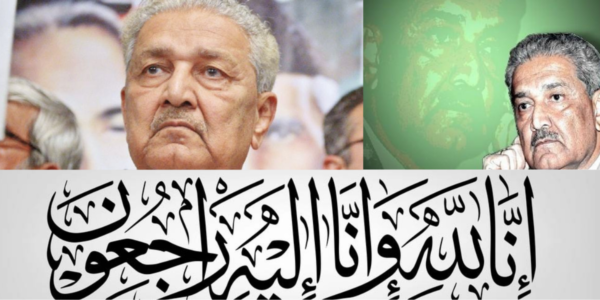Starting from scratch in 1976, he acquired the technology and knowledge that allowed Pakistan to detonate its first nuclear device in 1998.
Abdul Qadeer Khan, a metallurgist who became known to Western intelligence services as the father of Pakistan’s nuclear bomb and a worldwide dealer in weapons technology, died Sunday at a hospital in Islamabad, Pakistan. He was believed to be 85 years old.
Dr. Khan’s death was reported by Pakistan’s interior minister, Sheikh Rasheed Ahmad. The apparent cause was complications from Covid-19, he said.
Dr. Khan was the man who made Pakistan a nuclear power. For at least 25 years, starting from scratch in 1976, he built, bought, bartered and stole the makings of weapons of mass destruction.
To millions of Pakistanis, he was a national hero, the man who developed a nuclear program to match the country’s rival, India. To the C.I.A., he was one of the more dangerous men on earth.
Pakistan’s prime minister, Imran Khan, on Sunday said that he was “deeply saddened” by Dr. Khan’s death, praising him for “his critical contribution in making us a nuclear weapon state.”
“This has provided us security against an aggressive, much larger nuclear neighbor,” Mr. Khan tweeted, referring to India. “For the people of Pakistan he was a national icon.”
In a 2010 interview with Geo TV, a private Pakistani television network, Dr. Khan said that he had been motivated by the events of 1971, when Bangladesh, then known as East Pakistan, broke away to become an independent country following a bloody civil war in which Indian forces backed the separatists.
“My objective in making the atomic bomb was that Pakistan becomes safe,” he said. “I wanted that what happened in 1971 should never be repeated again.”
In March 2001, President Pervez Musharraf of Pakistan, under pressure from the United States, said he had forced Dr. Khan from his post as the head of the country’s national nuclear laboratory. But he remained a scientific adviser to the Musharraf government, and his ability to sell or barter nuclear technology continued.
The C.I.A. had long suspected “that Khan was sharing his deadly expertise beyond Pakistan’s borders,” the former C.I.A. director George J. Tenet wrote in his 2007 memoir. “His range of international contacts was broad — in China, North Korea, and throughout the Muslim world.” The C.I.A. believed “that he was trading nuclear expertise and material for other military equipment — for example, aiding North Korea with its uranium-enrichment efforts in exchange for ballistic missile technology.”

An international effort led by British and American intelligence agencies uncovered parts of the Khan network at the start of the 2000s. It discovered a global web of scientists, front companies and factories that it believed had transferred weapons technology to Iran, Libya, South Africa and North Korea.
The great fear was that a terrorist organization such as Al Qaeda would buy or steal the makings of a nuclear weapon.
Mr. Tenet wrote that he confronted Mr. Musharraf in a New York hotel suite on Sept. 24, 2003, during a meeting of the United Nations General Assembly.
“A.Q. Khan is betraying your country,” Mr. Tenet said he told the Pakistani leader. “He has stolen some of your nation’s most sensitive secrets and sold them to the highest bidders.” In his own memoir, Mr. Musharraf called this moment a profound embarrassment.
On Jan. 31, 2004, the government of Pakistan dismissed Dr. Khan. Shortly thereafter it announced that he had admitted helping the nuclear-weapons programs of Iran, North Korea and Libya. He confessed on national television four days later, saying his work was that of a rogue scientist and that his government never approved the sales or transfers of weapons technologies. The explanation was not widely accepted outside Pakistan.
Mr. Musharraf publicly pardoned Dr. Khan, who was suspected of personally profiting from his dealings. But he said the nation’s leading nuclear scientist would spend the rest of his days under house arrest.In the 2010 television interview, Dr. Khan, looking like a typical retiree, wearing sandals and seated cross-legged on a sidewalk, denied involvement in nuclear proliferation, and said that neither he nor his family had engaged in corruption. He expressed bitterness at his treatment by the Pakistani state, especially Mr. Musharraf.
“I am not unhappy with the people of Pakistan. But I am not happy with the hypocrite rulers,” Dr. Khan said. Later, he added: “The regret is about working for this nation. Sometimes I think I should have focused elsewhere. I should have pursued education, I should have become a professor. I had a lot of offers.”
Abdul Qadeer Khan was born in Bhopal, India, in either 1935 or 1936; the date is uncertain. After the partition of India in 1947, he was raised in Pakistan, the largely Muslim nation created by the division. He studied the science and technology of metals, and did graduate work in Germany.
In 1974, he was working in Amsterdam at a company that enriched uranium for a European consortium of nuclear-engineering firms. That same year, India tested its first nuclear weapon.
“When India conducted its nuclear explosions in 1974 and I felt that Pakistan’s security is in danger, I left everything and came back here,” Dr. Khan said.
He returned to Pakistan with two sets of blueprints for building centrifuges to enrich uranium. According to a later investigation by the Dutch government, those were the first of a series of nuclear-weapons designs and technologies that Dr. Khan purloined from abroad.
“They were importing materials and indeed the design, which was stolen from the Dutch,” Arthur W. Hummel Jr., the American ambassador to Pakistan from 1977 to 1981, said in a 1994 oral history interview. “They were putting together a ‘cascade’ of very high-speed centrifuges into which you put very rarefied, low pressure uranium in gaseous form. You ran it down this cascade long enough — for months and years — and you eventually got very highly enriched uranium,” the crucial material for a nuclear bomb.


“We had monitored their acquisition of these materials from around the world and did quite a bit to stop their obtaining some of them,” Mr. Hummel said. “Yet they were chugging ahead at a site that we knew about — which they flatly denied that they were doing. They had no choice but to deny it. We had no choice but to disbelieve them.”
On May 1, 1981, Gen. Mohammad Zia ul-Haq, the military ruler of Pakistan, renamed the nation’s nuclear-research complex as the Dr. A.Q. Khan Research Laboratories.
By the early 1980s, Pakistan’s pursuit of a nuclear bomb had become an open secret. “There is unambiguous evidence that Pakistan is actively pursuing a nuclear weapons program,” the State Department reported in a then-classified document dated June 23, 1983. It described in detail how Pakistan had bought, borrowed and stolen the technology to build the bomb.
In 1985, Congress passed a law requiring the president to certify that Pakistan was not producing nuclear weapons. Without that certification, Congress would cut off a large package of military aid to Pakistan, which was part of the American effort to support the resistance to the Soviet occupation of neighboring Afghanistan.
But for five years thereafter, President Ronald Reagan and President George H.W. Bush certified that Pakistan had no nuclear weapons program. Finally, in 1990 — after the Soviets had left Afghanistan — President Bush said he could no longer sign the annual certification.
Pakistan exploded its first nuclear device on May 28, 1998, in response to an Indian nuclear test. By that time, Dr. Khan had become an international pariah.
Mr. Khan, the prime minister, said that Dr. Khan would be buried at Faisal Mosque in Islamabad, the Pakistani capital. He is survived by his wife, Hendrina Khan, and two daughters, Dina Khan and Ayesha Khan.



1 Comment
Pingback: Youm-e-Takbeer Turn Pakistan into a Nuclear Power State - News Soluxionz